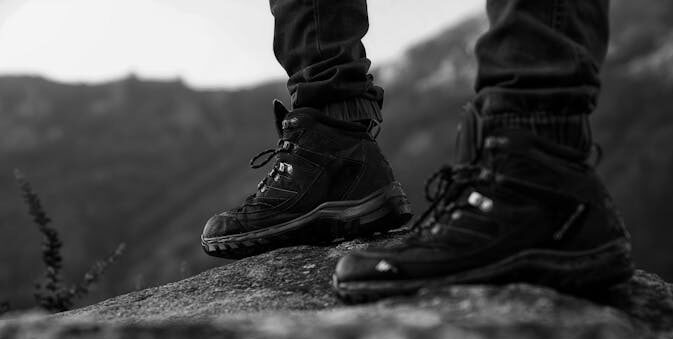
Whether you’re scaling mountains or taking a relaxed forest walk, keeping your hiking boots in good shape is vital. Well-maintained boots mean fewer blisters, more comfort, and a longer boot lifespan. Basically, if your boots are happy, your feet will be too.
Knowing how to care for walking boots is imperative. Boot care isn’t just a one-and-done deal. There are different stages: breaking in, waterproofing, cleaning, reproofing, and regular maintenance. Each plays a crucial role in ensuring your boots stay cozy, dry, and durable.
Breaking in new boots ensures they mold to your feet’s shape, avoiding those nasty blisters. Waterproofing keeps your feet dry when the weather takes a turn. Cleaning and reproofing post-hike remove grime and restore protective layers. Routine maintenance makes sure they’re always ready for your next adventure.
Think about it: you wouldn’t go on a road trip without tuning up your car, right? The same logic applies to your hiking boots. Proper care is like giving them a little TLC, ensuring they perform their best every time you step out. So, let’s gear up and get into the nitty-gritty of hiking boot care!
Breaking In New Boots
New hiking boots fresh out of the box might look epic, but wearing them straight onto a trail? Not the best idea. Gradually breaking in new boots is the way to go. Start by wearing them around the house or on short walks. This gives the material a chance to soften and mold to your unique foot shape. Some hiking shops will let you return the boots if they are uncomfortable, provided you have only worn them inside. It may be worth your while to ask if this is possible. Wearing in is critical with leather hiking boots as opposed to synthetic.
Quality hiking socks are key during this phase. Look for socks with good cushioning and moisture-wicking properties to keep your feet comfy and dry. In my 40 years of hiking, I have never scrimped on socks and swear by woolen socks. Want to take it up a notch? Custom insoles can provide extra support tailored to your foot’s needs, making your hike even more enjoyable.
Keep an ear out for squeaks or discomfort in specific spots. It’s better to address those issues now than when you’re halfway up a steep trail. Try adjusting the laces differently. Sometimes loosening or tightening specific areas can make a huge difference in comfort.
Remember, slow and steady wins the race here. Give yourself enough time to break in those boots before going on that epic hike. Your feet will thank you later! In fact, I would recommend that your first hike in new boots is a short one and relatively easy terrain.
Waterproofing and Care During Hiking
Before heading out, check if your boots have any waterproof features. Nothing ruins a hike faster than soggy feet, right? While many hiking boots come with built-in waterproof membranes, giving them additional waterproof treatments is a game-changer—especially for full-grain leather options. Products like spray-on waterproofing or waxes can add that extra layer of protection.
Now, let’s talk about what to do while you’re on the trail. Dirt, sand, and small rocks aren’t just annoying; they can damage your boots from the inside out. Make it a habit to clean out debris regularly during your hike.
Taking breaks? Use that time wisely. Air out your boots and remove the insoles if you’re stopping for a while or camping overnight. This helps reduce moisture buildup and keep your boots fresh.
Mud might seem harmless, but leaving it on, especially on leather boots, is a no-no. Clean it off as soon as possible to prevent drying and cracking. And here’s a big tip: don’t dry your boots near direct heat like campfires or radiators. Instead, use newspaper or cloth to absorb moisture naturally—keep swapping it out every few hours for best results.
Remember, a little attention during your hike goes a long way in maintaining your boots. Think of it as a quick pit stop in a road race—minor but crucial for the long haul.
Cleaning, Reproofing, and Conditioning After Hiking
After a solid day on the trails, your boots deserve some TLC. Start by removing the laces and insoles. Clean those separately using warm water to get rid of any grime.
Next, rinse your boots with cold water—you can use a brush to gently scrub off mud and dirt. Skip the detergents; specialized products designed to clean hiking boots work wonders without damaging the material.
Don’t forget the insides! Wipe down the interior to get rid of any sweat, salt, or dirt buildup. This helps keep things fresh and prolongs the life of the boots.
For full-grain leather boots, applying wax is essential. Grab a cloth, apply the wax evenly, let it dry, and then buff it out. This prevents the leather from drying and cracking. Boots made of nubuck, suede, or fabric need a spray-on reproofing product—let it dry naturally.
Depending on how often you use your boots, reproofing them regularly is key to maintaining their water resistance. Keeping that extra layer of protection ensures you’ll have dry and comfortable feet, hike after hike.
Drying, Storage, and Routine Maintenance
Drying your boots naturally is a must. Direct heat sources like radiators or campfires are a big no-no. They can warp the material and degrade the adhesives. Instead, stuff your boots with newspaper to absorb moisture. Swap out the paper every six to twelve hours until they’re fully dry.
When it comes to storage, location matters. Keep your boots in a cool, dry, well-ventilated area, away from direct sunlight. This prevents any potential damage from UV rays and ensures they stay in top condition.
If your boots spend a lot of time on the shelf, make a habit of wearing them periodically. This keeps the glue flexible and prevents degradation. No one wants their trusty hiking boots falling apart mid-hike!
Routine maintenance is crucial for longevity. After every adventure, give your boots a thorough cleaning and a bit of care. Every month or so, go the extra mile—wax treatments, cleaning the laces, and paying special attention to the front flex points to avoid cracking. This is also a great time to inspect them for damage. The last thing you want is a sole coming off or a lace breaking mid-hike. Believe me it happens, I recently did a hike where a fellow hiker’s sole started detatching from the front of their boot. Luckily between us we had duct tape and tools to do a rough repair job to allow them to complete the walk comfortable and safely.
This is the exasct reason why, it’s smart to be prepared for any on-trail mishaps. Carry spare laces , a good adhesive and duct tape for quick fixes. If the outsole starts detaching, dry the area, apply adhesive, and secure it with duct tape until you can make permanent repairs. Better safe than sorry! Happy Hiking!
If you have any questions or would like to share your hiking shoes experience, please leave your comments below.

Hi Lyn,
My wife and I hike a lot, and honestly, I have to admit I’ve always just taken my boots off, tossed them in the corner, and replaced them when they wore out after a year or two. I never really thought about the importance of giving them proper care. Your common-sense tips about taking a few minutes to clean and maintain boots really hit home—especially when you compared it to vehicle maintenance! Now that I think about it, I should’ve been doing this all along. Keeping my boots (and feet) in better shape is such an easy way to make them last longer and stay comfortable.
This was such a great read, and I’m definitely going to start giving my boots the TLC they deserve. I’m looking forward to your future content—thanks again for sharing such practical advice!
Best,
Opa
This article provides such an insightful guide on taking care of hiking boots, which is essential knowledge for any hiker! Proper boot care really does make a huge difference in comfort and longevity. I’ve had a few pairs over the years, and the advice on breaking them in slowly to avoid blisters is spot on. I’ve learned the hard way that skipping waterproofing can lead to a very uncomfortable hike if the weather changes unexpectedly. The post-hike cleaning routine outlined here is also crucial—I once left mud on my boots, and it dried out the leather faster than I realized. Now, I follow similar steps to keep my boots in good condition. This article is a must-read for anyone serious about hiking!